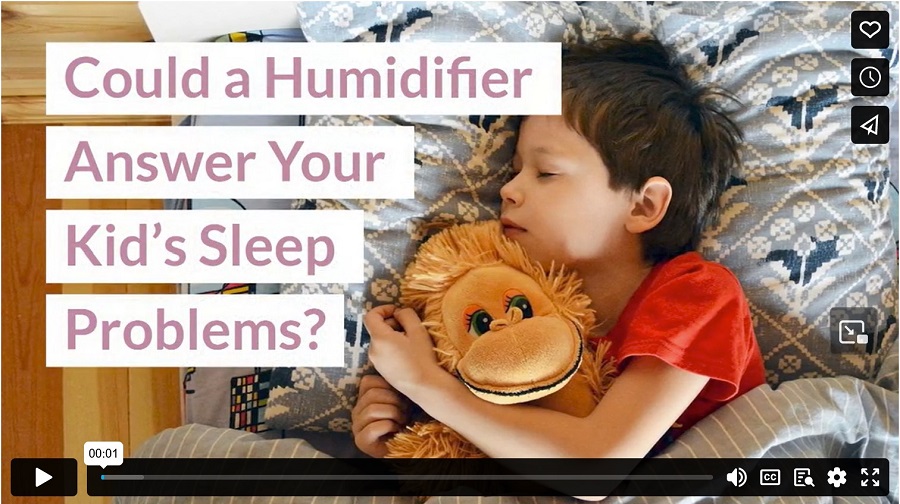There are a few combinations in life that you just can’t deny:
- Macaroni and cheese
- Summertime and swimming pools
- Peanut butter and jelly
- Fall and football games
- Hammer and nails
- Thunder and lightning
Today we pose a slightly less known (but no less true!) pairing: humidifiers and childhood. The humidifier is the magical tool that seems to be the cure all for a wide variety of ailments – including poor sleep! But what makes the humble humidifier so great, and how can you utilize its full potential? Those and many other questions answered in this blogpost.
Why are humidifiers helpful?
Your humidifier will be your child’s best friend throughout the year. During sickness, the soothing mist can help soothe irritation from a persistent cough or stuffy nose. It’s a particularly great kid sleep help for young children who can’t take cough syrup or suck on cough drops to alleviate symptoms. In the wintertime, humidifiers also put moisture into the air, relieving dry skin, bloody noses, and dry or irritated eyes and airways.
Perhaps most importantly, humidifiers can improve sleep for the entire family. Coughing and congestion tend to act up most at night, and a humidifier can help calm down some of those symptoms. Additionally, it can quiet snoring if inflamed nasal passages are the culprit. If your kid won’t sleep without white noise, many humidifiers also create a gentle humming sound that is peaceful for children and encourages slumber.
What’s the difference between cool mist and warm mist humidifiers?
Cool mist and warm mist humidifiers have the same outcome (tiny water droplets in the air), but they create the mist differently.
There are two main kinds of cool mist humidifiers: ones with filters and ones without filters. Filter-free humidifiers, also called ultrasonic humidifiers, have a small piece that vibrates so quickly that it turns liquid water into a vapor. The fan and tube then force the mist out into the room.
Humidifiers with filters use an evaporative process to put vapor into the air. Basically, they use a filter to wick up water, and then a fan blows on the liquid water to evaporate it.
Warm air humidifiers use a heating element to turn the liquid water into steam, and then a fan pushes the moisture into the room. By the time the vapor hits the air in the room, it’s cool again, but you still need to exercise caution. The American Academy of Pediatrics recommends that parents use a cool mist humidifier in their children’s rooms because the heating element inside a warm mist humidifier poses a burn risk.
Where should I put the humidifier?
There are two main things to consider when placing your humidifier:
- It is out of your child’s reach. You don’t want them pulling a full humidifier down on themselves or getting tangled up in the cord.
- The mist isn’t falling directly onto their bodies or faces when they sleep. Six feet away is a good rule of thumb because it will get the room humid, but you don’t have to worry about finding your child covered in morning dew.
What should I look for in a humidifier?
There are a ton of different humidifiers on the market, so you need to get something that works best in your home environment. Here are some things to think about:
-
- Antimicrobial material: Some plastic materials can get gunked up more quickly than others. If you don’t have a lot of time to scrub your humidifier, look for one made using antimicrobial material. You’ll still have to clean it regularly, but it’s designed to resist mold growing on it.
- Room size: Look at the product description for the ideal room size. If the humidifier is meant for small rooms, your child might not get the relief they need if their room is large. On the flip side, if the humidifier is intended for a large room and your child’s room is small, things could get too damp. Excessive dampness could lead to damaged furniture, carpets, and paint. When using a humidifier, you should never see condensation forming on the walls or furniture in your child’s room. If you do see it, you should turn the machine down, crack the door, or turn on a fan.
- Warm or cool mist: Both types of humidifiers create a cool mist, but the AAP recommends cool mist for children because warm mist humidifiers pose a burn risk for young children.
- Run time: Some humidifiers only run for a couple of hours before running out of water, while others can run almost two days straight.
- Filter/no filter: Filters can get downright nasty if you aren’t paying attention to them, so if you know you won’t check often, you might want a filter-free humidifier.
- Noise: If noise is an important factor in your home, you’ll need to do your research on this. Some humidifiers just have a quiet gurgling sound, while others create a lot of white noise.
- Cleanability: Humidifiers have a well-earned reputation for being hard to clean, so you need to look for models with wide openings to fit your hand through.
- Gadgets: Humidifiers really can do it all these days. They create soothing mist, but they can also project scenes onto the ceiling, provide white noise or lullabies, purify the air, and be used as a nightlight.
Are there any risks with using a humidifier?
There are three primary risks when you use a humidifier:
- Mold and microorganisms: Mold and other microorganisms love warm, damp environments, so a humidifier creates their dream hotel. You need to clean your humidifier every couple of days using a vinegar or bleach solution and change the water daily (preferably using distilled water). You also need to pay attention to the settings, so the room doesn’t get too damp.
- Electricity and water: These two things never mix, and though humidifiers have safety mechanisms built in to keep electricity and water from mixing, you should always use caution. Make sure to keep the humidifier out of your baby’s reach at all times.
- Heat: This risk only applies to warm mist humidifiers. Warm mist humidifiers boil the water to create steam which is a burn hazard for young children.
Even though there are a few risks associated with humidifiers, the pros far outweigh the cons. From clearer noses to quieter coughs to calmer sleep, a humidifier is a must for every home.
Infographic
The humidifier is the enchanted device that appears to be the panacea for a wide range of maladies, including restlessness! But what is it about the modest humidifier that makes it so fantastic, and how can you make the most of it? These and other inquiries are addressed in this infographic.

Video



